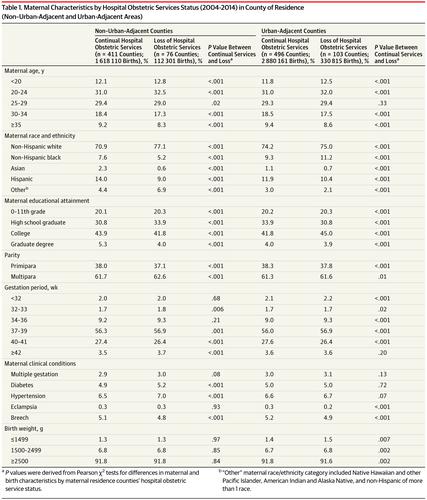Our official English website, www.x-mol.net, welcomes your
feedback! (Note: you will need to create a separate account there.)
Association Between Loss of Hospital-Based Obstetric Services and Birth Outcomes in Rural Counties in the United States
JAMA ( IF 63.1 ) Pub Date : 2018-03-27 , DOI: 10.1001/jama.2018.1830 Katy B. Kozhimannil 1 , Peiyin Hung 2 , Carrie Henning-Smith 1 , Michelle M. Casey 1 , Shailendra Prasad 1, 3
JAMA ( IF 63.1 ) Pub Date : 2018-03-27 , DOI: 10.1001/jama.2018.1830 Katy B. Kozhimannil 1 , Peiyin Hung 2 , Carrie Henning-Smith 1 , Michelle M. Casey 1 , Shailendra Prasad 1, 3
Affiliation

|
Importance Hospital-based obstetric services have decreased in rural US counties, but whether this has been associated with changes in birth location and outcomes is unknown. Objective To examine the relationship between loss of hospital-based obstetric services and location of childbirth and birth outcomes in rural counties. Design, Setting, and Participants A retrospective cohort study, using county-level regression models in an annual interrupted time series approach. Births occurring from 2004 to 2014 in rural US counties were identified using birth certificates linked to American Hospital Association Annual Surveys. Participants included 4 941 387 births in all 1086 rural counties with hospital-based obstetric services in 2004. Exposures Loss of hospital-based obstetric services in the county of maternal residence, stratified by adjacency to urban areas. Main Outcomes and Measures Primary outcomes were county rates of (1) out-of-hospital births; (2) births in hospitals without obstetric units; and (3) preterm births (<37 weeks’ gestation). Results Between 2004 and 2014, 179 rural counties lost hospital-based obstetric services. Of the 4 941 387 births studied, the mean (SD) maternal age was 26.2 (5.8) years. A mean (SD) of 75.9% (23.2%) of women who gave birth were non-Hispanic white, and 49.7% (15.6%) were college graduates. Rural counties not adjacent to urban areas that lost hospital-based obstetric services had significant increases in out-of-hospital births (0.70 percentage points [95% CI, 0.30 to 1.10]); births in a hospital without an obstetric unit (3.06 percentage points [95% CI, 2.66 to 3.46]); and preterm births (0.67 percentage points [95% CI, 0.02 to 1.33]), in the year after loss of services, compared with those with continual obstetric services. Rural counties adjacent to urban areas that lost hospital-based obstetric services also had significant increases in births in a hospital without obstetric services (1.80 percentage points [95% CI, 1.55 to 2.05]) in the year after loss of services, compared with those with continual obstetric services, and this was followed by a decreasing trend (−0.19 percentage points per year [95% CI, −0.25 to −0.14]). Conclusions and Relevance In rural US counties not adjacent to urban areas, loss of hospital-based obstetric services, compared with counties with continual services, was associated with increases in out-of-hospital and preterm births and births in hospitals without obstetric units in the following year; the latter also occurred in urban-adjacent counties. These findings may inform planning and policy regarding rural obstetric services.
中文翻译:

美国农村县医院产科服务的丧失与出生结果之间的关联
重要性 基于医院的产科服务在美国农村县有所减少,但这是否与出生地点和结果的变化有关尚不清楚。目的探讨农村县医院产科服务缺失与分娩地点和分娩结局的关系。设计、设置和参与者 一项回顾性队列研究,在年度间断时间序列方法中使用县级回归模型。使用与美国医院协会年度调查相关的出生证明确定了 2004 年至 2014 年在美国农村县发生的出生。参与者包括 2004 年所有 1086 个有医院产科服务的农村县的 4 941 387 名新生儿。按与城市地区的邻近程度分层。主要结果和措施 主要结果是县(1)院外分娩率;(二)在没有产科的医院分娩的;(3) 早产(<37 周妊娠)。结果 2004 年至 2014 年间,179 个农村县失去了以医院为基础的产科服务。在研究的 4 941 387 名新生儿中,平均 (SD) 产妇年龄为 26.2 (5.8) 岁。平均 (SD) 75.9% (23.2%) 的分娩妇女是非西班牙裔白人,49.7% (15.6%) 是大学毕业生。与城市地区不相邻且失去医院产科服务的农村县的院外分娩率显着增加(0.70 个百分点 [95% CI,0.30 至 1.10]);在没有产科病房的医院分娩(3.06 个百分点 [95% CI,2.66 至 3.46]);和早产(0.67 个百分点 [95% CI,0.02 到 1.33]),在失去服务后的一年,与那些有持续产科服务的人相比。与城市相邻的农村县失去医院产科服务后的一年内,在没有产科服务的医院分娩的人数也显着增加(1.80 个百分点 [95% CI,1.55 至 2.05])。持续产科服务,随后呈下降趋势(每年 -0.19 个百分点 [95% CI,-0.25 至 -0.14])。结论和相关性 在不毗邻城市地区的美国农村县,与提供持续服务的县相比,医院产科服务的丧失与院外和早产以及在没有产科病房的医院分娩的增加有关。下一年; 后者也发生在邻近城市的县。这些发现可为有关农村产科服务的规划和政策提供信息。
更新日期:2018-03-27
中文翻译:

美国农村县医院产科服务的丧失与出生结果之间的关联
重要性 基于医院的产科服务在美国农村县有所减少,但这是否与出生地点和结果的变化有关尚不清楚。目的探讨农村县医院产科服务缺失与分娩地点和分娩结局的关系。设计、设置和参与者 一项回顾性队列研究,在年度间断时间序列方法中使用县级回归模型。使用与美国医院协会年度调查相关的出生证明确定了 2004 年至 2014 年在美国农村县发生的出生。参与者包括 2004 年所有 1086 个有医院产科服务的农村县的 4 941 387 名新生儿。按与城市地区的邻近程度分层。主要结果和措施 主要结果是县(1)院外分娩率;(二)在没有产科的医院分娩的;(3) 早产(<37 周妊娠)。结果 2004 年至 2014 年间,179 个农村县失去了以医院为基础的产科服务。在研究的 4 941 387 名新生儿中,平均 (SD) 产妇年龄为 26.2 (5.8) 岁。平均 (SD) 75.9% (23.2%) 的分娩妇女是非西班牙裔白人,49.7% (15.6%) 是大学毕业生。与城市地区不相邻且失去医院产科服务的农村县的院外分娩率显着增加(0.70 个百分点 [95% CI,0.30 至 1.10]);在没有产科病房的医院分娩(3.06 个百分点 [95% CI,2.66 至 3.46]);和早产(0.67 个百分点 [95% CI,0.02 到 1.33]),在失去服务后的一年,与那些有持续产科服务的人相比。与城市相邻的农村县失去医院产科服务后的一年内,在没有产科服务的医院分娩的人数也显着增加(1.80 个百分点 [95% CI,1.55 至 2.05])。持续产科服务,随后呈下降趋势(每年 -0.19 个百分点 [95% CI,-0.25 至 -0.14])。结论和相关性 在不毗邻城市地区的美国农村县,与提供持续服务的县相比,医院产科服务的丧失与院外和早产以及在没有产科病房的医院分娩的增加有关。下一年; 后者也发生在邻近城市的县。这些发现可为有关农村产科服务的规划和政策提供信息。









































 京公网安备 11010802027423号
京公网安备 11010802027423号